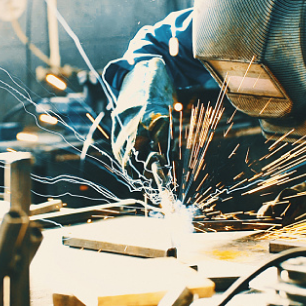Jump to:
The Answer Is
Q: I have this problem at work. My employer fabricates heavy structural steel, and we’re having issues with inconsistent weld quality. Our reject rate using flux cored arc welding is way too high — about 20% for fillet welds and around 10% for groove welds. With large single pass fillet welds, the biggest problems are incomplete fusion at the root and slag inclusions. With groove welds, we’re experiencing incomplete fusion, rope-like weld beads, and slag inclusions. We’re also seeing incomplete joint penetration when making complete joint penetration welds from both sides. “Chicken tracks” also occasionally appear on the face of both fillet welds and groove welds. What steps can be taken to improve the weld quality in our shop?
A: You mentioned having problems with flux cored arc welding (FCAW). You didn’t mention whether you are using a self-shielded (-S) flux cored electrode or a gas-shielded (-G) flux cored electrode. Because you said your employer fabricates heavy structural steel, it is probably safe to assume you are using a gas-shielded flux cored electrode. However, many of the recommendations I’m about to make are applicable to both FCAW-G and FCAW-S.
One problem I consistently encounter is allowing each welder to set the welding parameters based on what feels right. When you see a welder telling his team member to increase the voltage and turn down the amperage and then, after several adjustments, declaring it perfect, you have a welder setting the welding parameters based on what feels right. That’s a problem.
This is not an easy question that allows for a simple yes or no answer. It’s complicated. I’ll answer the question with a two-part response. Part two will be in the November Inspection Trends.
Typical Weld Discontinuities
There are some basic steps when trying to correct a problem.
Step 1: Identify the Problem
Begin by identifying the specific issue and performing a root cause analysis. In this case, you have identified the problem as being a failure to achieve the level of weld quality necessary to satisfy the client. I would ask whether the customer’s expectations are to meet the requirements of a code or if the client imposed more-restrictive requirements. That could be something as simple as a requirement for material traceability or visual weld criteria that is more stringent than AWS D1.1, Structural Welding Code — Steel.
Step 2: Ensure Everyone Understands the Requirements
Review your employer’s quality program. Ask yourself whether it includes provisions for the additional requirements imposed by the customer. Does your employer’s quality system include a mechanism to ensure everyone is aware of the code and customer-
imposed requirements? “Everyone” includes the purchasing department, incoming receiving inspectors, and warehouse, inspection, and production personnel. The last group consists of the layout and fitup personnel, welders, and painters.
There may be specific requirements that the personnel in each department must be aware of. I’ve seen failures at each stage of manufacturing, from the purchasing department ordering the wrong material or not requesting certified material test reports (CMTRs) to receiving inspection not reviewing the ASTM specifications to compare the chemistry listed by the CMTR to that of the ASTM material specification to electrodes not being properly stored in the warehouse. I’ve seen raw materials not being properly segregated, resulting in cross contamination of stainless steel with carbon steel or copper alloy because the storage racks did not segregate different alloys. You name it, I’ve probably seen it; each represents a failure in the quality system.
Step 3: Determine Whether the Issue Is Systemic or Individual
The cause of the quality failures needs to be identified. Were failures caused by systemic problems with the quality system, or did they result from someone not doing their job? Does your employer’s quality system include a mechanism to catch these deficiencies before the product is shipped, or does the customer’s inspector get involved?
The quality system includes the drawings as well as the welding procedure specification (WPS). The company has to review the project specifications when working up a quote. The review should include the company’s WPSs to determine whether the existing WPSs are sufficient as they are, need to be revised, or require the development of a new WPS to cover the needs of the work being quoted.
Both the drawings and WPSs are working documents used by production personnel. With some companies, the team consists of a layout person, a fitter/tacker, and the welder, who work together to fabricate a weldment. The drawings provide essential information, such as materials, dimensions, weld type, size, length, location, etc. The WPS provides the welder with essential information, including the welding process, base metal, filler metal, shielding gas, welding parameters, weld types, and geometry of the connection. The welder is expected to work within the limitations of the WPS; as such, they expect the WPS to be complete, accurate, and in an easily understood format.
The first indication that the drawings are incomplete or incorrect is when production stops so engineering can address their shortcomings. The first indication there is a problem with the WPS is when the welder doesn’t review it while setting up for a new job or can’t locate it when asked, “Where is your WPS?”
Step 4: Investigate Welder-Related Issues before Reassigning Work
Let’s say the quality system is intact, functioning as intended, and it’s established the welder is the problem. As mentioned in the post, typical weld defects include undersized welds, insufficient weld length, and weld profile issues such as undercut, overlap, slag inclusions, and elongated porosity. Where does one start to correct those deficiencies?
At first, it may seem expedient to simply assign a “better” welder to make a repair. That may take care of the immediate need, but it is an expensive, short-term solution that cuts into the company’s profit margin and doesn’t represent a viable long-term solution. A better approach is to determine the root cause of the unacceptable weld.
Consider the following:
- If the weld is too short, was the length marked out on the workpiece?
- If the weld is undersized, was the size marked out on the workpiece?
- In the case of a fillet weld:
- Did the welder have a ruler to check the weld length?
- Did the welder have a set of fillet weld gauges to verify the size?
- In the case of a groove weld:
- Was the preparation of the groove checked to verify it met the dimensions specified by the WPS?
- Was the groove filled to at least flush with the adjacent surfaces?
Size, length, grooves-filled flush: These are dimensional deficiencies that should be easily addressed if the welder checks the weld before passing it on to the next station or approving it for inspection. If they aren’t checking the weld upon completion, why not? Do they know how to use the tools needed to check the weld length or size? Do they know how to check the length of the weld increment and the unwelded space between increments of an intermittent joint?
Step 5: Provide Corrective Training
Corrective action: Train the welder how to properly measure welds if it is determined they don’t know how to use the tools. Don’t just demonstrate the process once and walk away. Have them use the tools to accurately measure several samples.
Porosity and Other Weld Defects
Elongated porosity is one of those discontinuities that is a workmanship issue. It is cosmetic in that it doesn’t look good, but it doesn’t materially reduce weld strength. Elongated piping porosity is typically confined to the face reinforcement of the groove weld or the convex face of a fillet weld. It typically has a rounded bottom and rounded end conditions. The presence of elongated porosity could indicate the electrode extension is too short. If the welder increases the electrode extension, the amperage drops and the problem usually disappears. If that doesn’t do the trick, slightly reduce the wire feed speed.
Piping porosity is addressed in AWS D1.1. It is the result of a gas bubble working up through the trailing edge of the solidifying weld pool while the weld is in the mushy state. It forms a hole that extends from the weld face into the weld, extending down toward the root. It reduces the weld cross section and strength. AWS D1.1 includes visual acceptance criteria for piping porosity. Welding on a rusty or painted surface, a lap joint with moisture trapped between components, or any other surface contaminant can produce piping porosity. Make sure the joint is clean and dry before welding.
A double groove weld that has incomplete joint penetration is typically caused by one of two issues: either the welder didn’t back gouge deep enough or the geometry of the back gouge does not provide sufficient access for back welding (i.e., the aspect ratio of depth to width is insufficient). According to AWS D1.1, the back gouge should resemble a prequalified J- or V-groove. As for the depth, I use the following formula:
Depth of back gouge (BG) of the second side = (thickness of the base metal minus the depth of the preparation of the first side) plus an additional 1/8 in.
Or, to write it another way:
BG2 = (T – DP1) + 1/8 in.
The depth of the back gouge is easily checked with the blade of a combination square. As for the shape, one should be able to touch the bottom of the back gouge with the tip of their index finger without touching the groove face to either side. I made two gauges using the band strapping from a bundle of steel using tin snips. One gauge is the minimum size; the second gauge is the maximum size based on AWS D1.1.
When addressing weld defects like incomplete fusion, piping porosity, elongated porosity, slag inclusions, and so on, one of the things I review is the welding parameters listed by the WPS, asking the question, “Is the welder working within the acceptable ranges?” From my experience, many welders set the welding parameters based on what they always use, what they used on the last job, or what feels right. My usual response to those answers is, “Houston, we have a problem.”
Coming Next
The next installment will address how to set the welding parameters for flux cored arc welding.
ALBERT J. MOORE JR. (amoore999@comcast.net) is owner of NAVSEA Solutions, Burlington, Conn. He is an AWS Senior Certified Welding Inspector and an ASNT NDT Level III. He is also a NOCTI certified welding instructor.
The Society is not responsible for any statements made or opinions expressed herein. Data and information developed by the authors are for specific informational purposes only and are not intended for use without independent, substantiating investigation on the part of potential users.


